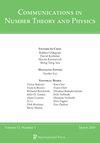Calabi-Yau 模块形式的兰金-科恩括号
IF 1.7
3区 数学
Q1 MATHEMATICS
引用次数: 0
摘要
$def/M/{mathscr{M}}/def/Rscr{/mathscr{R}}/def/Rsf/mathsf{R}}/def/Tsf/mathsf{T}}/def/tildeM/widetilde/{M}}$对于任意正整数$n$、我们在一个由德沃家族产生的增强卡拉比-尤 $n$ 折叠的模空间 $\Tsf$ 上引入一个模向量场 $\Rsf$ 。与 $\Rsf$ 相关的 Calabi-Yau 准模态形式指的是由 $\Rsf$ 的解生成的有级 $\mathbb{C}$-algebra $\tildeM$ 的元素,这些元素具有自然权重。模向量场 $\Rsf$ 在 $\tildeM$ 上诱导了导数 $\Rscr$ 和拉曼努琼-塞尔型导数 $\partial$。我们证明它们都是度数为 2$ 的微分算子,并且存在一个适当的子空间 $\M \subset \tildeM$,称为与 $\Rsf$ 相关的 Calabi-Yau 模形式空间,它在 $\partial$ 下是封闭的。利用导数 $\Rscr$,我们定义了 $\tildeM$ 的兰金-科恩括号,并证明由 $\M$ 的正权重元素生成的子空间在兰金-科恩括号下是封闭的。我们根据卡拉比-尤模块形式找到了德沃家族的镜像映射。本文章由计算机程序翻译,如有差异,请以英文原文为准。
Rankin–Cohen brackets for Calabi–Yau modular forms
$\def\M{\mathscr{M}}\def\Rscr{\mathscr{R}}\def\Rsf{\mathsf{R}}\def\Tsf{\mathsf{T}}\def\tildeM{\widetilde{\M}}$For any positive integer $n$, we introduce a modular vector field $\Rsf$ on a moduli space $\Tsf$ of enhanced Calabi–Yau $n$-folds arising from the Dwork family. By Calabi–Yau quasi-modular forms associated to $\Rsf$ we mean the elements of the graded $\mathbb{C}$-algebra $\tildeM$ generated by solutions of $\Rsf$, which are provided with natural weights. The modular vector field $\Rsf$ induces the derivation $\Rscr$ and the Ramanujan–Serre type derivation $\partial$ on $\tildeM$. We show that they are degree $2$ differential operators and there exists a proper subspace $\M \subset \tildeM$, called the space of Calabi–Yau modular forms associated to $\Rsf$, which is closed under $\partial$. Using the derivation $\Rscr$, we define the Rankin–Cohen brackets for $\tildeM$ and prove that the subspace generated by the positive weight elements of $\M$ is closed under the Rankin–Cohen brackets. We find the mirror map of the Dwork family in terms of the Calabi–Yau modular forms.
求助全文
通过发布文献求助,成功后即可免费获取论文全文。
去求助
来源期刊

Communications in Number Theory and Physics
MATHEMATICS, APPLIED-MATHEMATICS
CiteScore
2.70
自引率
5.30%
发文量
8
审稿时长
>12 weeks
期刊介绍:
Focused on the applications of number theory in the broadest sense to theoretical physics. Offers a forum for communication among researchers in number theory and theoretical physics by publishing primarily research, review, and expository articles regarding the relationship and dynamics between the two fields.
 求助内容:
求助内容: 应助结果提醒方式:
应助结果提醒方式:


